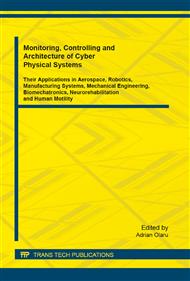[1]
ISO 6983-1: 2009 Numerical Control of Machines – Program Format and Definition of Address Words – Part 1: Data Format for Positioning, Line Motion and Contouring Control Systems, (2009).
DOI: 10.3403/30455688
Google Scholar
[2]
R. Stryczek, B. Pytlak, Elastyczne programowanie obrabiarek, Wydawnictwo Naukowe PWN (2011).
Google Scholar
[3]
W. Zebala, L. Slusarczyk, Komputerowe wspomaganie projektowania i wytwarzania w programie CAD/CAM KELLER, Wydawnictwo Politechniki Krakowskiej, (2012).
Google Scholar
[4]
J. Pobozniak, Algorithm for ISO 14649 (STEP-NC) feature recognition, Management and Production Engineering Review, VOL. 4, No. 4, December (2013).
DOI: 10.2478/mper-2013-0037
Google Scholar
[5]
ISO 10303-1: 1994 Industrial automation systems and integration – Product data representation and exchange – Part 1: Overview and fundamental principles, (1994).
DOI: 10.3403/00572116
Google Scholar
[6]
ISO 10303-203: 2011 Industrial automation systems and integration – Product data representation and exchange – Part 203: Application protocol: Configuration controlled 3D design of mechanical parts and assemblies, (2011).
DOI: 10.3403/00663618
Google Scholar
[7]
J. Duda, J. Pobozniak: Machining process planning in PLM environment, Technical Transactions 1-M/2013, Cracow (2013).
Google Scholar
[8]
ISO 14649-1. 2003. Industrial automation systems and integration – Physical device control – Data model for computerized numerical controllers – Part 1: Overview and fundamental principles, (2003).
DOI: 10.3403/30455618u
Google Scholar
[9]
ISO 14649-10. 2004. Industrial automation systems and integration – Physical device control – Data model for computerized numerical controllers – Part 10: General process data, (2004).
DOI: 10.3403/30455619
Google Scholar
[10]
ISO 14649-11: 2004 Industrial automation systems and integration – Physical device control – Data model for computerized numerical controllers – Part 11: Process data for milling.
DOI: 10.3403/30455638
Google Scholar
[11]
B. Babic, N. Nesic, Z. Milijkovic, A review of automated feature recognition with rule-based pattern recognition, Computers in Industry, Volume 59, Issue 4, April (2008).
DOI: 10.1016/j.compind.2007.09.001
Google Scholar
[12]
S. M. Amaitik, S. E. Kiliç, An intelligent process planning system for prismatic parts using STEP features, The International Journal of Advanced Manufacturing Technology, January 2007, Volume 31, Issue 9-10.
DOI: 10.1007/s00170-005-0269-5
Google Scholar
[13]
Y. Yusofa, K. Caseb, Design of a STEP compliant system for turning operations, Robotics and Computer-Integrated Manufacturing, Volume 26, Issue 6, December (2010).
DOI: 10.1016/j.rcim.2010.05.002
Google Scholar
[14]
Xu, Xun; Nee, Andrew Yeh Ching (Eds. ), Advanced Design and Manufacturing Based on STEP, Springer (2010).
Google Scholar


